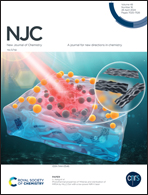Design of Fe and N co-decorated biomass-derived hierarchical porous carbon frameworks with boosted oxidase-like activity for hydroquinone detection†
Abstract
The exploration of efficient, easily fabricated and inexpensive carbon-based nanozymes with accessible active sites is important for expanding the applications of nanozymes. In this study, an Fe and N co-decorated porous carbon framework (Fe–N–C) derived from walnut shells was designed and prepared by microenvironment modulation consisting of chemical activation and pore-making engineering. The hierarchical pore size distribution not only can increase the exposure of defects and provide a suitable environment for the favorable incorporation of Fe–Nx active sites into carbon matrixes, but also can provide a higher specific surface area to facilitate substrate binding. For these reasons, the prepared Fe–N–C material was found to possess excellent oxidase-like activity, which could catalyze the activation of dissolved oxygen to produce reactive oxygen species (ROS) to oxidize chromogenic substrates. Interestingly, this oxidase mimic behavior would be effectively suppressed by an antioxidant – hydroquinone (HQ). Based on this observation, we proposed a sensitive and visible colorimetric platform for HQ assay, with a detection limit of 0.09 μM. This research not only provides new ideas for the preparation of economical carbon-based nanozymes, but also further expands the application of biomass-based carbon materials as nanozymes in the field of environmental pollutant detection.



 Please wait while we load your content...
Please wait while we load your content...